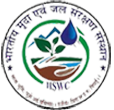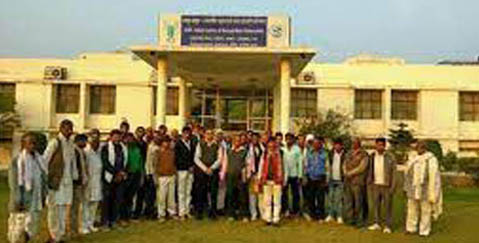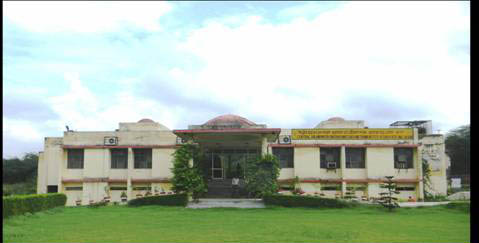Agra
Background
In India, there are about 4 M ha of ravine lands, which is 1.22 per cent of the total geographical area (328 M ha), spread over 12 states. In Uttar Pradesh, the ravine lands occupy an area of about 1.23 M ha of which 0.18 M ha exists in Agra district on the bank of river Yamuna and its tributaries.
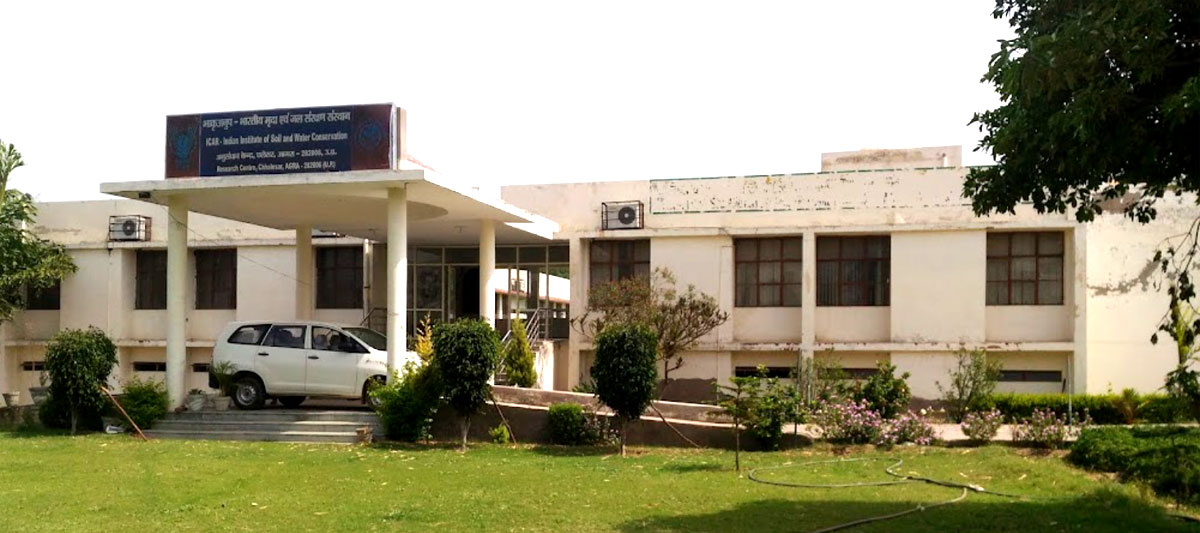
The problem of ravines has become a serious threat because the ravines are dynamic and on a conservative estimate it takes annual toll of above 8000 ha of valuable lands of the country. The ever increasing demand of food, fuel and fodder has attracted the attention of the Government of India towards the useful utilization of these otherwise waste lands.
Consequently, the Government of India established a network of Soil Conservation Research Demonstration and Training Centre in the country. The soil conservation Research Demonstration and Training Centre, Agra, though established in 1955 as a sub-centre, became an independent center in 1957 with the main objective of developing scientific and technical know how to deal with the problems of ravine lands on the banks of Yamuna river. In order to give a coordinated approach to the problem of soil and water conservation research, in April, 1974 the ICAR upgraded the Dehra Dun Centre to the status of a Research Institute, and redesignated it as the CENTRAL SOIL AND WATER CONSERVATION RESEARCH AND TRAINING INSTITUTE. Consequently, Agra Centre came under the administrative umbrella of the Institute with the present name "Central Soil and Water Conservation Research and Training Institute", Research Centre Agra.
Mandate
- Appraisal of ravines problem and conservation of land and water resources under different land uses along the Yamuna river system.
- Evaluation of hydrological behaviour and management of watersheds for reducing sediment discharge, improving water regime and productivity
- Evaluation and identification of suitable plant materials for different land uses in ravine lands according to land capability.
- Development of suitable technology for increasing production from ravine lands.
- Monitoring changes in environment as affected by land uses and management practices.
- Development of techniques for stabilization of ravine lands.
- Development of techniques for (a) rainfed farming and (b) efficient water management in ravine lands.
- Demonstration of the soil and water conservation practices for improving production on farmers land.
SCIENTISTS
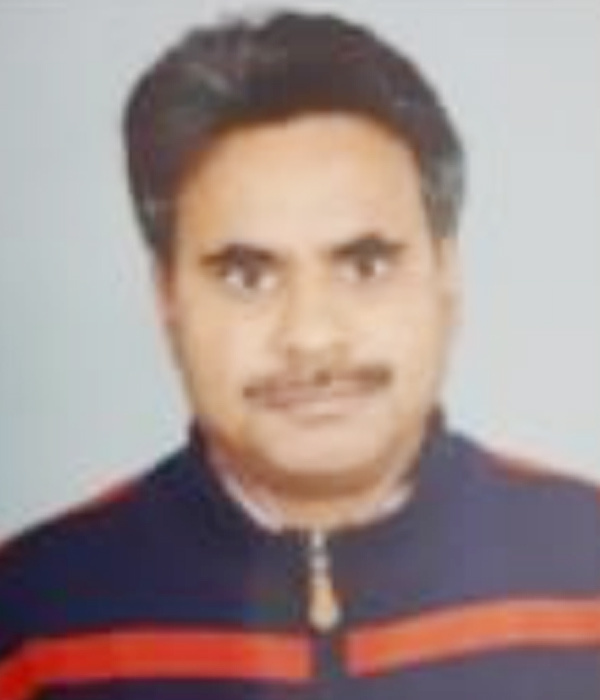
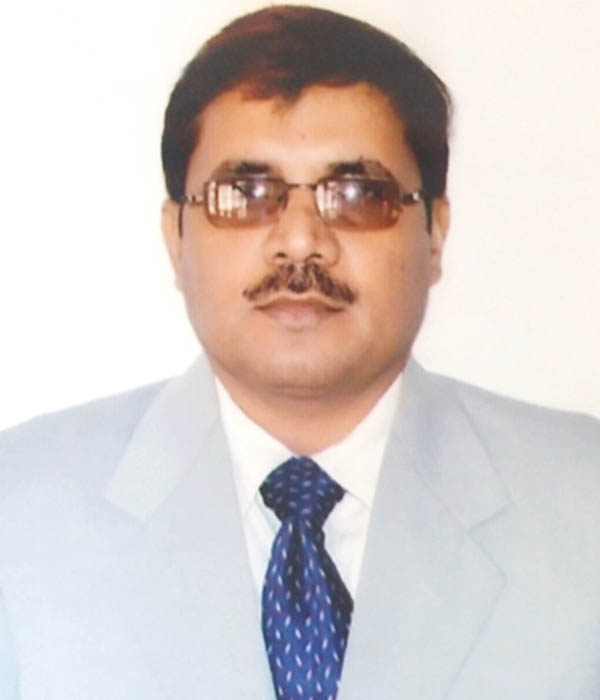
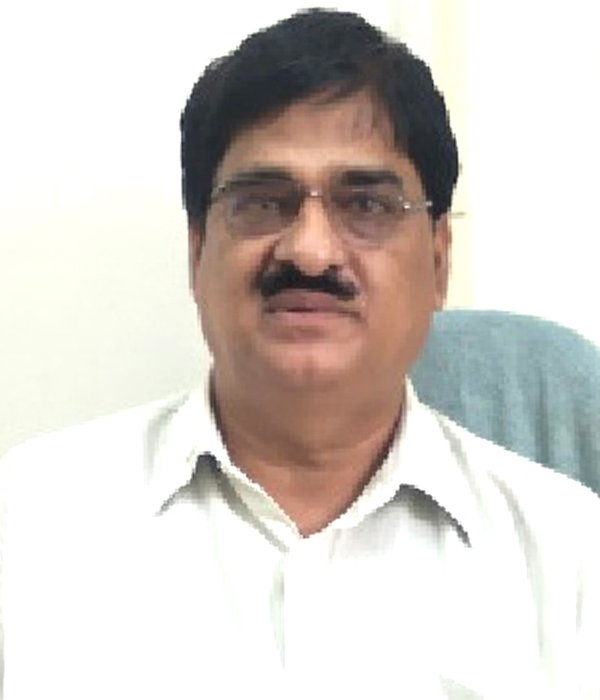
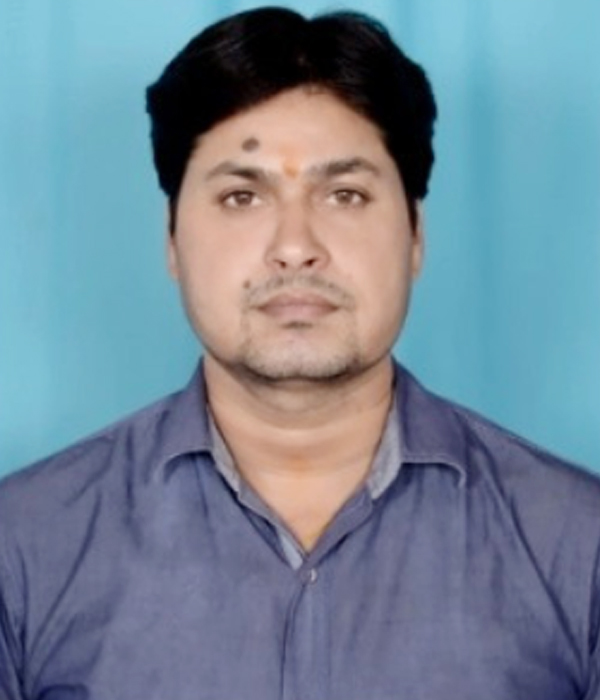

Infrastructure
The Centre has a state of art Office cum Laboratory complex housing a Training hostel, Library, Exhibition hall, Seminar room, ARIS cell, Administrative office and Guest house.
Soil Laboratory
 To cater to the needs of research and training, the centre is well equipped with the modern facilities for analyzing soil and water. The centre has modern instruments and equipments for analysis of soil, plant and water and facilities for monitoring soil-plant-atmospheric continuum.
To cater to the needs of research and training, the centre is well equipped with the modern facilities for analyzing soil and water. The centre has modern instruments and equipments for analysis of soil, plant and water and facilities for monitoring soil-plant-atmospheric continuum.
Modern and sophisticated instruments like Atomic absorption spectrophotometer, Pressure plate apparatus, Neutron moisture meter, Double beam spectrophotometer, Flame photometer, Yoder apparatus, Nitrogen assembly and other facilities for runoff monitoring, leveling and surveying instruments.
Agricultural Research Information System (ARIS)
 The Centre has provided computer facilities with internet connectivity to most of the scientific and administrative staff. All the computers are connected through LAN and have internet facilities through V sat.
The Centre has provided computer facilities with internet connectivity to most of the scientific and administrative staff. All the computers are connected through LAN and have internet facilities through V sat.
There are adequate number of scanners, laser printers (colour and black & white), deskjet printers and Xeroxing facilities. The centre is also equipped with Geographical Information System (GIS) and Global Positioning System (GPS) for research purpose and imparting and training.
Library
 The centre has an excellent library with having sitting arrangement for around 30 persons.
The centre has an excellent library with having sitting arrangement for around 30 persons.
The library is updated with new journals, books and periodicals every year and has collection of 2160 books. Currently 15 journals related to soil and water conservation are being subscribed by the library.
Research
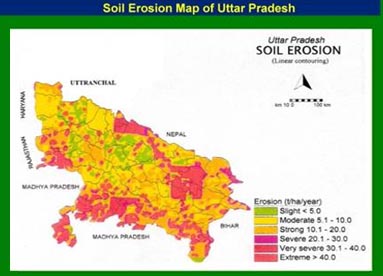 Soil erosion rates were computed by universal soil loss equation for the state of Uttar Pradesh. The soil data at a grid 10 km interval was collected by NBSSLUP regional centre, Delhi, which was made available to the center. By utilizing these data the soil erosion map of Uttar Pradesh and Uttarakhand were prepared in collaboration with NBSSLUP.
Soil erosion rates were computed by universal soil loss equation for the state of Uttar Pradesh. The soil data at a grid 10 km interval was collected by NBSSLUP regional centre, Delhi, which was made available to the center. By utilizing these data the soil erosion map of Uttar Pradesh and Uttarakhand were prepared in collaboration with NBSSLUP.- The design and technical suitability required for conservation measures for ravine regions have been optimized at the research center, Agra. The arable land are treated with measures like land leveling, terracing, bunding etc. and non arable land with contour trenching, gully plugging, check dams etc.
 Deep tillage produced maximum grain yield (2480 kg ha-1) of rainfed pearl millet which was about two times more than the farmers’ practice (1399 kg ha-1) i.e. cultivator twice every year. Yield of wheat was also found almost in similar trend
Deep tillage produced maximum grain yield (2480 kg ha-1) of rainfed pearl millet which was about two times more than the farmers’ practice (1399 kg ha-1) i.e. cultivator twice every year. Yield of wheat was also found almost in similar trend- Soil loss tolerance limit on soil mapping unit basis has been computed for the states of Uttarakhand, Uttar Pradesh and Delhi, which will help in developing conservation planning in these states.
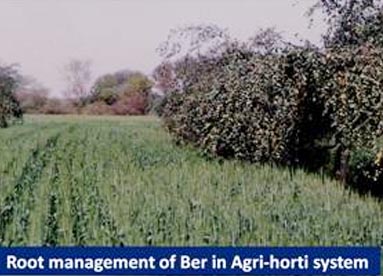 Root management of Ber in Agri-horti system could successfully reduce the adverse effect of Ber on wheat productivity. The higher average grain yield of pearlmillet (2982 kg ha-1) and wheat (4192 kg/ha) were recorded with tree planted in bottomless drum compared to other root management practices.
Root management of Ber in Agri-horti system could successfully reduce the adverse effect of Ber on wheat productivity. The higher average grain yield of pearlmillet (2982 kg ha-1) and wheat (4192 kg/ha) were recorded with tree planted in bottomless drum compared to other root management practices.- Soil erodibility factor (K) of USLE has been computed from 10 years of study for the soils of Agra. Similarly, crop cover factor (C) has been computed for Cenchrus ciliaris, moong, cowpea, sesamum, clusterbean, pearl millet and castor. It was lowest for Cenchrus ciliaris (0.08) and highest for castor (0.45).
 Study of growing of cotton under limited irrigation condition at 60 x 60 cm spacing indicated that one life saving irrigation during hot dry season given to the cotton crop at 21 days after sowing is sufficient for obtaining higher crop productivity under semi arid condition. Cotton – wheat cropping is more beneficial (Rs. 35350 ha-1) than that of pearlmillet-wheat (Rs. 16516 ha-1) cropping system.
Study of growing of cotton under limited irrigation condition at 60 x 60 cm spacing indicated that one life saving irrigation during hot dry season given to the cotton crop at 21 days after sowing is sufficient for obtaining higher crop productivity under semi arid condition. Cotton – wheat cropping is more beneficial (Rs. 35350 ha-1) than that of pearlmillet-wheat (Rs. 16516 ha-1) cropping system.- Study on runoff and soil loss under different cropping system has indicated that maximum runoff (204 mm i.e. 44% of rainfall) and soil loss (12.8 t/ha) occurred from cultivated fallow and minimum runoff (29 mm) and soil loss (0.3 t/ha) was recorded from C. ciliaris grass plot. Among various cropping systems, the soil loss was maximum (4.0 t ha-1) from sole bajra crop and it was reduced to about half when cowpea/moong was grown as intercrop in bajra.
 When the ravine terrain is irregular and reclamation not economical, a series of staggered trenches in the watershed reduces the run-off from 25% to nil. The system works well to stabilize and control ravine extension and encourages tree species and grasses to come up naturally to provide protection and economic return from such lands. Grass production increased from 3 t ha-1 yr -1 to 15.6 t ha-1 yr -1, on account of better soil and moisture conservation. Natural regeneration of trees occured and stocking of 2140 trees per ha was achieved within 10 years.
When the ravine terrain is irregular and reclamation not economical, a series of staggered trenches in the watershed reduces the run-off from 25% to nil. The system works well to stabilize and control ravine extension and encourages tree species and grasses to come up naturally to provide protection and economic return from such lands. Grass production increased from 3 t ha-1 yr -1 to 15.6 t ha-1 yr -1, on account of better soil and moisture conservation. Natural regeneration of trees occured and stocking of 2140 trees per ha was achieved within 10 years.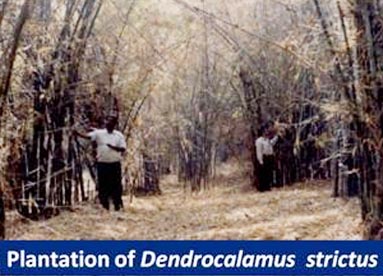 Suitable silvipasture system for development of fodder resources and fuel wood has been developed. To increase the economic productivity of the gully bed, plantation of Dendrocalamus strictus has been successfully achieved. About 4000 to 5000 mature culms/ha could be harvested every year from the bamboo plantation on the ravine bed.
Suitable silvipasture system for development of fodder resources and fuel wood has been developed. To increase the economic productivity of the gully bed, plantation of Dendrocalamus strictus has been successfully achieved. About 4000 to 5000 mature culms/ha could be harvested every year from the bamboo plantation on the ravine bed.- The centre has developed many low cost and effective soil conservation structures such as prefabricated drop structure and modified chute spillway for safe disposal of runoff water.
Cultivation of low moisture and nutrient demanding medicinal crops like Aloe vera with tree found to be a suitable alternate land use option. - V shaped micro catchments with 50 % slope covered with polythene lining produced maximum run off which was stored in the soil profile around the root zone of the tree. Applying this treatment, a maximum ber yield of 40 q ha-1 could be obtained.
- The jetty sloping downstream is effective in diverting the river current away from the bank and maintaining still water or reduces flow velocity for a longer distance downstream than the jetties sloping up stream.
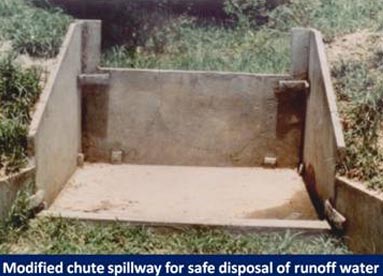

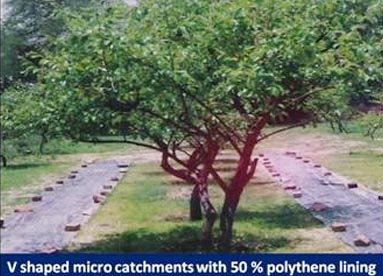
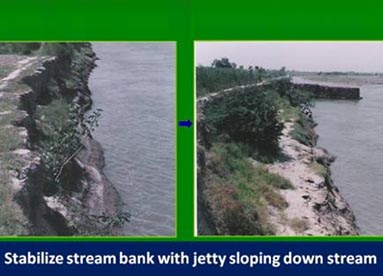
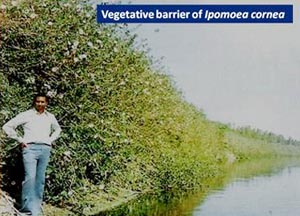 Vegetative barrier of Ipomoea carnea has been used to stabilize stream bank. To reinforce resisting power of Ipomea, Tarmarix dioica and Prosopis juliflora were also planted which encouraged deposition of silt. Thus the process of bank erosion was reversed to land reclamation and channelisation of river into a straight course.
Vegetative barrier of Ipomoea carnea has been used to stabilize stream bank. To reinforce resisting power of Ipomea, Tarmarix dioica and Prosopis juliflora were also planted which encouraged deposition of silt. Thus the process of bank erosion was reversed to land reclamation and channelisation of river into a straight course.
Training
The centre has training halls equipped with all modern audio-visual aids like LCD, desk microphones, TV, DVD player, computer etc. A trainee’s hostel with 40 fully furnished rooms and two air-conditioned guest room for VIPs are also available.
Eminent scientists having expertise in the field of Soil Science & Agronomy, Engineering, Forestry, Economics, Extension, and Horticulture, are available at the centre for conducting research and training on different aspects of natural resource management. Senior faculty members are also invited from sister organizations to give lectures to the trainees.
Research, training and extension programmes of the Centre are carried out by following sections:
- Watershed Hydrology and Engineering
- Land and Water
- Plant Science & Horticulture
- Economics and Statistics
Besides, there are centralized activities at the Centre which are carried out by different units as follows:
- Technical Cell- Photography, editing and publishing
- Cartography
- Farm Management
- Administration and Accounts
Seminar Room
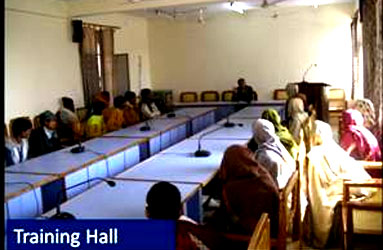
The seminar room is well furnished with a sitting capacity of 50 persons. It is fitted with conferencing facility consisting of audio-system with detachable cable mounted microphones, audio visual projection system (LCD) with multi -media projector, computer, television, DVD player, video and digital camera.
Exhibition Hall
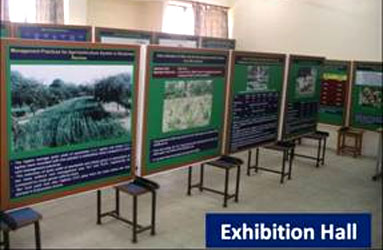
Research Farm
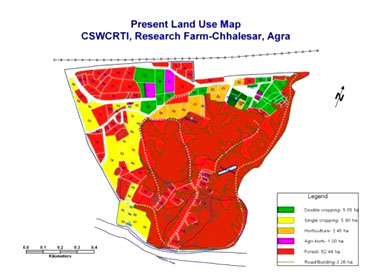 The Centre has a Research Farm of 81.6 ha attached to this Centre is located at village, Chhalesar, situated on Agra-Kanpur National Highway at a distance of 14 km from Agra city. The Research Farm represents of the typical features of the ravine system on the banks of Yamuna river and is an ideal site for research dealing with stabilization, reclamation and utilization of ravine lands.
The Centre has a Research Farm of 81.6 ha attached to this Centre is located at village, Chhalesar, situated on Agra-Kanpur National Highway at a distance of 14 km from Agra city. The Research Farm represents of the typical features of the ravine system on the banks of Yamuna river and is an ideal site for research dealing with stabilization, reclamation and utilization of ravine lands.
The research farm is well equipped with research facilities like runoff plots of different slopes and sizes, terraced land and horticultural blocks for conducting research on conservation aspects, gauged forested watershed and ravine lands for hydrological and forestry research.
Various land use options are available for conducting and demonstrating research on soil and water conservation. The farm also has circulatory set up for simulation studies and permanent plots for ecological succession studies.
Meteorological Observatory
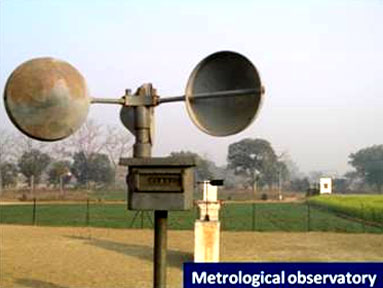 The centre has ‘A’ class meteorological observatory fully equipped with all the modern instruments for gathering information on all the meteorological parameters to assist scientific work and cater to the need of other Government/Research organizations.
The centre has ‘A’ class meteorological observatory fully equipped with all the modern instruments for gathering information on all the meteorological parameters to assist scientific work and cater to the need of other Government/Research organizations.
Collaboration
Human Resource Development and Extension Activities
In India, there are about 4 M ha of ravine lands, which is 1.22 per cent of the total geographical area (328 M ha), spread over 12 states. In Uttar Pradesh, the ravine lands occupy an area of about 1.23 M ha of which 0.18 M ha exists in Agra district on the bank of river Yamuna and its tributaries.
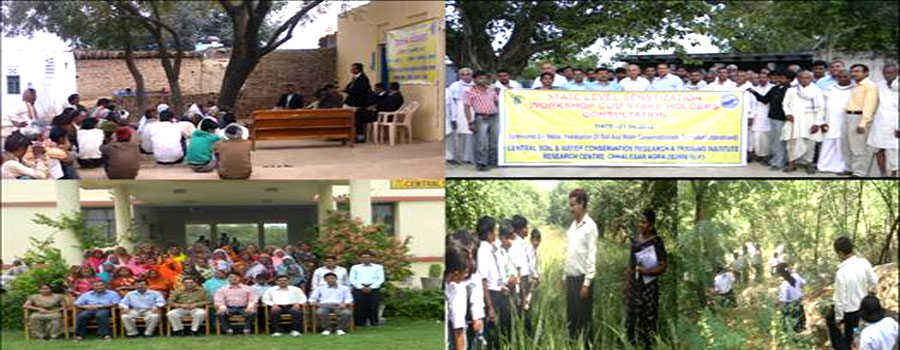
The problem of ravines has become a serious threat because the ravines are dynamic and on a conservative estimate it takes annual toll of above 8000 ha of valuable lands of the country. The ever increasing demand of food, fuel and fodder has attracted the attention of the Government of India towards the useful utilization of these otherwise waste lands. Consequently, the Government of India established a network of Soil Conservation Research Demonstration and Training Centre in the country.
Consultancy
The centre has expertise in providing consultancy on watershed planning and development, monitoring and impact evaluation of watershed, ravine reclamation and watershed hydrology and water resource development and these includes:
- Hydrological monitoring and environmental rehabilitation of degraded lands
- Watershed hydrology and water resources development ravines
- Impact assessment of natural resource conservation programme
- Monitoring and impact evaluation of watershed programme
- Integrated wasteland development
- Integrated participatory watershed development planning and management
- Ravine land reclamation and rehabilitation of degraded Yamuna ravines
Collaboration/Linkage
The Centre during the period is associated with different Government Ministries, National Organizations, State Universities and Developmental Agencies in conducting various research programmes and in transferring the technologies developed into the farm situation.
- Ministry of Rural Development
- Ministry of water Resources
- Department of Agriculture & Cooperation
- State Universities
- NABARD
- National Bamboo Mission
- Central Institute for Research on Goats
- NRC Agro forestry



